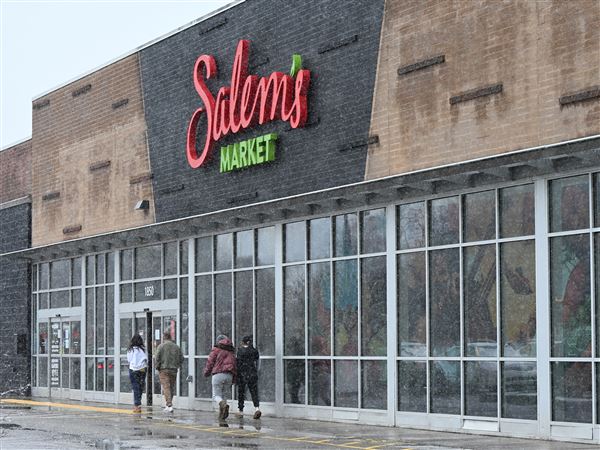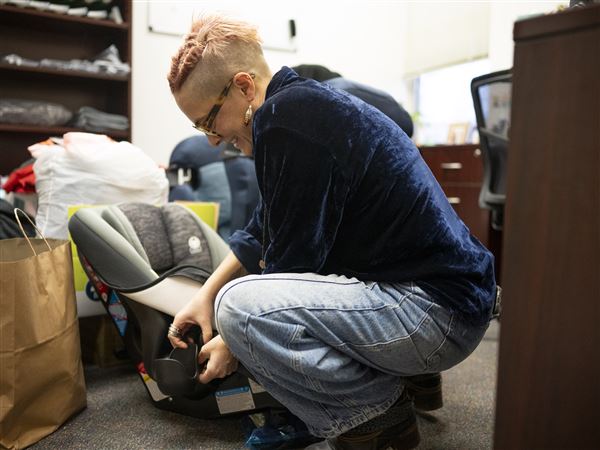Diana Gray, a U.S. Housing and Urban Development official, visited the city's East Hills neighborhood two years ago and asked a boy there what he wanted to be when he grew up.
Doctor? Firefighter? Police officer?
"I can be a drug lookout," he said.
"That's illegal," she said. "Aren't you afraid of going to jail?"
"Everyone I know has been in jail," the boy said.
He was 8.
This is what has often passed for ambition in the three isolated East Hills subsidized-housing neighborhoods that hug the hill behind the abandoned site of the former East Hills Shopping Center.
Second East Hills, Third East Hills and Maple Ridge, all privately owned Section 8 communities, have long symbolized urban decay.
The low point may have been an August 2005 gang-related killing at a playground in Second East Hills.
But that crime also sparked a revolution of sorts, and some good things have been happening since.
A model $85 million effort coordinated by HUD, the FBI, the U.S. Bureau of Alcohol, Tobacco, Firearms and Explosives, city police and two private developers has been steadily improving life for this neighborhood, where 90 percent of the households are headed by single black women.
The East Hills Area Restoration Initiative has quietly renovated housing, cleaned out drug dealers, and provided some job and educational opportunities.
Crime has clearly declined in the past few years, due in large part to an effort by Victory Security, a private force whose officers are being trained by two ATF agents and the Pittsburgh police.
Other security firms have operated in East Hills over the years with questionable results. But this one is vetted by federal agents and works directly with them.
Their East Hills Intervention Team also includes probation officers, among them Ted Johnson, head of U.S. Probation and Pre-Trial Services, who has a personal stake in the future of East Hills in part because he lives nearby in Penn Hills.
"Lots of other projects start, and then when the agencies leave, everything returns to how it was," he said during a tour of the property. "This one, we go in, we stay there."
In addition to improved safety, which surveys showed was the top priority for residents, jobs are finally coming.
Wal-Mart said last month that it will break ground, probably in May, on the acres of forlorn asphalt where the shopping center once stood on land shared by Penn Hills, Wilkinsburg and the city.
Lowe's has also made a commitment to build.
Claudia Wells, a 59-year-old great-grandmother who has lived in the neighborhood since 2000 and is a member of the Second East Hills tenant council, calls the Wal-Mart promise "our economic angel."
"It was like a lost continent here," she said one day while caring for her grandson's two babies. "It's like night and day compared to how it was. We have the redevelopment for bricks and mortar. Now we're changing the mindset."
Her daughter, Monique Shorter, 35, who lives nearby with her own 14-year-old son, was visiting and helping to care for the babies when she got a call on her cell phone.
It was a friend happily telling her she'd qualified to move into Second East Hills, where rents are subsidized by HUD.
"People are excited to move up here," said Ms. Shorter, who earned her General Educational Development degree through an East Hills program, graduated from Empire Beauty School and now hopes to open a salon near the Wal-Mart site.
"East Hills is on its way up."
The old institutional feel of the place is gone.
In Second East Hills, New York-based developer Telesis Corp. individualized the 326 units with new designs and bright colors.
It cost $44 million, but the neighborhood now looks more like a suburban development than a housing project.
"The physical condition has improved, so people have pride," said Sharon Fields, a community volunteer who lives with her 19-year-old son, a technical school student in the process of moving into his own apartment. "Before, it looked like a concentration camp. Now, it's pepped up."
Telesis also built an immaculate community center for meetings, after-school programs and domestic seminars.
The company intends to tear down the nearby Third East Hills co-op community of 140 units and rebuild them, too.
That effort had been stalled by a federal lawsuit filed by some residents who feel they are being forced out. But Patricia Baylock of CT Management, which supervises the Telesis properties, says she expects the project to get rolling within 30 days despite the suit.
Maple Ridge, an adjacent community of 91 high-rise units formerly known as First East Hills, has also undergone a facelift, this one by Boston-based Winn Companies.
"We're trying to put the neighbor back in the hood," said Herman Watson, the property manager. "This is a lost community."
The neighborhood still has the problems of subsidized housing anywhere -- absent fathers, scarce jobs, generations of welfare recipients.
What's more, there are concerns that the crackdown on crime has merely pushed it into neighboring communities.
Wilkinsburg has been actively involved in the initiative, but Penn Hills hasn't. So, federal authorities say, the criminals are being funneled into the Penn Hills neighborhoods adjacent to East Hills.
Howard Burton, the Penn Hills police chief, did not respond to a request for comment.
While shots-fired calls are down in the subsidized part of East Hills and no one has been killed since 2005, there were still four homicides nearby in the larger East Hills neighborhood last year.
In addition, the shuttered East Hills Elementary School also remains empty. There's talk of it becoming a business incubator, but so far nothing's happened.
"We have a long way to go," said Lillie Leonardi, the FBI community outreach specialist who brought the agencies together in 2005 at the request of former Sen. Rick Santorum. "We probably have at least three to five years [of commitment]."
Change is incremental here. This year's goal: to establish a day-care center.
Some residents have tried to make a difference on their own. In the summer, a group of older women set up a reading group for children while their mothers worked.
"We want people to know," said Ms. Wells, "that this is their community."
Drive into Second East Hills and you can bet Lt. Randy Canella is watching you.
The gruff, leather-jacketed daylight shift supervisor for Victory, he takes his job so seriously that he monitors security cameras off-duty from his home computer in Bridgeville.
On the site, he's everywhere. During one recent meeting of agency heads, he sat in the back and listened but his eyes were fixed on the street outside.
He knows every car driving through and every person walking by.
And if he doesn't, he soon will. Like any good beat cop, his philosophy is to meet the people.
"We've built relationships," he said. "We had to work to gain respect, not just from residents but from other law enforcement."
During the meeting, he suddenly received a report of a man with a gun and tromped out into the snow with his troops. They quickly found the resident and patted him down. It was a false alarm -- he didn't have a gun and they let him go.
But this kind of scenario plays out daily.
Most of the trouble-makers aren't residents but boyfriends, some on probation, parole or pre-trial supervision, visiting young women in the units.
"A lot of these girls just don't understand that they should not be hanging around with seedy sorts," said resident Joyce Woods, 57.
It was worse before the anti-crime blitz. Cocaine and heroin customers, often white suburbanites from as far off as Slippery Rock, drove to East Hills to buy. An open market thrived, with dealers using the women to gain access to apartments so they could sell dope.
Pittsburgh officers answered calls, but there was no regular police presence.
"It was like the Wild West," said Ms. Gray, head of multi-family housing at HUD. "There was shooting daily. On the weekends you couldn't leave your apartment. There were elderly women whom I met who hadn't left their apartments in two years. When children went to the school bus, their mothers would walk around them to form a circle."
The new team approach to law enforcement now ensures that no one who doesn't belong here goes unnoticed.
Darnell Washington couldn't hide.
Indicted on federal drug charges in West Virginia, he was out on bond last summer when he started showing up in East Hills.
Police knew he had a suspended license, a violation of his supervised release, so when they spotted him driving around on July 2 the arrested him.
Mr. Washington, 20, is now serving two years in a federal prison in Oklahoma City.
The EHIT team, which posts pictures of wanted men in the security office and maintains a list of all those arrested (53 since May), has had to tackle the same suspects repeatedly because they keep coming back.
One August day, ATF supervisor Lou Weiers was driving out of the area when he saw two Victory officers trying to control a crowd.
The center of attention: Damon Johnson, 18, who was trying to fight with someone.
Agent Weiers and the guards took him into custody and removed a gun from him. He went to jail but got out on bond.
When he showed up at East Hills again in November, police tried to pull him over and chased him into Wilkinsburg. Officers found him carrying 223 stamp bags of heroin, according to an incident report.
"If he comes up here again," said Lt. Canella, "he's going to be stopped."
The law enforcement presence has emboldened some residents to provide information when before they might have looked the other way.
Last summer, for example, tipsters reported that Raymond Crumby, 35, an intimidating presence at 6-feet-5, 240 pounds, was dealing crack out of Maple Ridge. When Lt. Canella confronted him, according to a police report, Mr. Crumby said he was visiting a relative but couldn't give an address or name. Lt. Canella told him to leave and not come back.
But on Dec. 11, according to the report, he returned and Lt. Canella recognized him. City Officer Jeff DeSchon confronted him again, and again he said he was visiting a relative but couldn't give a name.
During the conversation, Mr. Crumby suddenly bolted and Officer DeSchon tackled him on Wilner Drive. Police and security said they found crack on him and took him to jail.
"They removed him quietly," said Mr. Watson, the property manager. "He had been up here and then one day he wasn't. They're pros. The word is out now: Don't come up here."
Not every resident is pleased with this zero-tolerance approach.
Sharon Fields, who attended the recent agency-head meeting, complains that security is heavy-handed. But she herself was arrested in October by Pittsburgh police.
According to an incident report, officers had approached a young man in a hoodie on a warm night because they thought he was suspicious. Ms. Fields started swearing at them about harassing the man, police said, and ended up spending 12 hours in jail on a disorderly conduct charge.
Some residents also complain about "shoddy" construction of the units and chafe at the regulations imposed by management.
But Ms. Baylock, of CT Management, says the complaints are the result of a lack of enforcement in years past. HUD also says it has an obligation to protect such a sizable investment of public money.
"I think that people don't understand that there are rules," said Ms. Baylock. "They don't understand that there are consequences for their actions when they haven't been enforced before."
It takes time to develop bonds in a place like this, Ms. Leonardi said, because people have made promises in the past and then disappeared. And that still happens.
Andrew Cheeseboro, the recently-hired social services director for CT, had talked excitedly about getting programs going but then suddenly quit two weeks ago after less than a month on the job.
Overall, however, residents seem pleased. A poll taken last year showed an increase in tenant satisfaction compared to 2006.
"It's definitely improving," said Ms. Woods, who is on disability. "If I feel melancholy and want to go for a walk at night, I feel safe. Truly, you can walk around in the evening, even in the early morning, and you feel safe."
Trust is building.
"I know people are reluctant because they hear 'FBI' and 'ATF' and they get nervous," said Ms. Wells. "But they saw that [the feds] all have the same heart and the same mission. You see the heart."
First Published: February 10, 2008, 10:00 a.m.
















